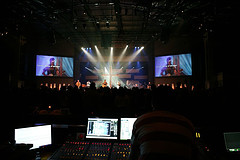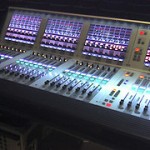
New Approaches

So here’s a rundown on some of the new stuff I’ve been adopting after attending Robert Scovill’s FOH course. A big theme of the course was coherency (system, mix, performance) so a lot of these fit with that. I’ll focus on drum stuff for now.
Overheads: Previously I was using the overheads more as close-mic’s for the cymbals. A few weeks ago I moved our overheads into an XY configuration. I was referring to this new approach as more of a “studio” approach around the office, but I’m going to stop because from looking around it is really sort of an approach unto itself. It IS more of a “kit” mic’ing approach, than a cymbal mic’ing approach. The idea is you get your overhead elements right next to each other so you get phase coherent arrival times of everything in the overheads; so, for example, your snare drum arrives in the left and right overheads at the same time. If you want to space your overheads over the kit you can get the same sort of thing if you measure the distance of the snare to each overhead and keep it consistent, however, you’ll still have different arrival times for everything else in the kit. The XY approach gives you coherency for the entire kit. I picked up an a mic stand adapter Scovi showed us that Shure makes for setting up mics in XY.
Since I was moving mics around, I used this opportunity to try some AKG451’s for overheads. I love these mics, but I wasn’t particularly sold on this role for them, although Dustin was bummed in the studio when I switched back to the KSM44’s. At some point I’m going to pick up a Rode NT4 to try out. I’m also going to try our 414’s when I get them back from Buckhead, although I’m guessing they wants their 451’s back first…
Kit time alignment: With phase coherent arrival times at the overheads, I am also spending a little more time on getting the entire kit time aligned to the overheads. I’m doing this by delaying all the drum mics so they’re in time with the overheads. I don’t have any hard rules on this; there’s always a bit of compromising to do because everything is bleeding into everything on the kit. At a minimum I make sure that the snare is time aligned in the overheads, and I make sure that the two kick mics are in phase.
Kit/Tom Gates: I adjusted my gates so that they’re expanders. Something Robert talked about is that when two signals are interferring and comb filtering is taking place, if one of those signals is at least 6 dB less the comb filtering won’t bother you as much. So I’m letting my gates breathe a little more now just taking them down enough reduce comb filtering…and cymbals along the way… Previously I was only using gates on the toms, but I’m experimenting with them again on the snare and kick here and there; I’ve been playing with them in rehearsals, but I don’t think I’m leaving them on for actual services.
One benefit I’m finding of using expanders on the toms and the new way I’m using the overheads is I’m not losing as many tom hits to gates that are too tight. With the overheads giving a better picture of the overall kit and the gates set as expanders, the lighter hits still come through. Eventually I’m going to key my gates with a trick Scovi gave us, but I need extra channels to do it, and I don’t have them right now. In the meantime this is works better than using the snapshots to tweak the gates for each song or relying on memory to punch them in and out where necessary.
Kick mic experiment: One last thing I tried with the drums is a new kick mic. I picked up a B stock Audio-Technia AE2500 to try in our kick drum. The mic feature two elements: a condenser and a dynamic. The mic fits with the phase coherency theme because both elements are phase coherent. I tried the mic out a couple weeks ago, and I have mixed feelings about it. On the one hand I thought it gave the kick a much more natural sound. On the Sunday I used it we did a Carrie Underwood song that I really liked it on. However, I wasn’t overly thrilled with how it worked on the rock worship. As a more natural mic, it lacks that aggressive hyped kick-drumness that I’m used to. We’ve since gone back to our Sennheiser 902/Shure Beta91 combination. I’m going to try the AE2500 again next weekend when I’m mixing in our west auditorium where we’re still running analog and I don’t have the same tools to do all the time alignment stuff I can do with the Venue. The bottom in that room is also more of a challenge so I’m going to see how it works.

 Next Post
Next Post



Do you guys ever record/post online any of the special music you do in services? I’d definitely be interested to hear them!
It’s pretty rare that we put music up from Sunday mornings. There are a lot of copyright and licensing issues to deal with.
I think we had everything online from Easter in the streaming video, and you can probably still find it in the sermon or message archive–I forget what it’s called–on the northpoint.org website. I think there was music at the front and back of the service. The mix on there would have been done in the studio. If you can get past the lousy data compression, you can get a feel for what we’re doing week to week.
You mention kit time alignment, and I’m curious as to what you use to align everything via time.
You said you delayed all the drum mics so that they’re in time with the overheads, how do you go about doing this?
Also, you mention “phase coherent” I’m not as familiar with phases as I need to be, could you elaborate on that just a tad?
Thanks so much!
I’m doing the kit time alignment by using the channel delay on the Venue. By delaying the close mics with the console, I can get them to output through the PA at the same time which gives me phase coherence.
Phase is a big deal with audio, and I would suggest doing a Google search on comb filtering to understand more about it. Here’s a very basic introduction because it’s easier for me to explain with a diagram. Whenever you combine a sound with a delayed version of the sound, you can get constructive and destructive interference. In the case of a drum kit with multiple microphones, the sound from a snare drum will reach the mic on the snare sooner than it will reach the overheads. When these two sounds combine in the mixer and output through the PA, the offset between arrival times at the mics causes comb filtering which can affect the tone of the snare drum.
Phase is really just where a wave is in regards to its cycle. When I say something is “phase coherent”, that just means that the cycle of the waves of two versions of the same sound are in sync. Going back to the drum example, having phase coherency means that all instances of the sound of a snare drum that is being captured by multiple microphones(snare mic, tom mics, hat mic, overheads) on a drum kit are reproduced by the loudspeakers at the same time. Having an XY overhead setup ensures that all sounds captured by the overheads arrive at each microphone at the same time so that I don’t need to worry about trying to delay the individual channels to get phase coherency.
Very good description.
I looked back and read literally, every single one of your blogs and also found the diagram you drew of it.
Then it clicked, I must say you do a very good job of describing everything.
Finding this has been a huge huge blessing.
I go to Buckhead, but I’m moving soon and I attend 7|22
This coming week will be my last, you won’t by any chance be there?
I’d love to meet ya.
Thanks again!
I’m not usually at 7|22 because Dustin mixes it. But I’m around pretty much every Sunday if you want to swing by then.
I wish I could but I’ll be gone by then.
I’ll be back to visit I’m sure, and I’ll always be coming to this blog.
Thanks for the blessing of this blog.
Aaron